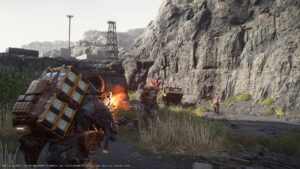
Death Stranding 2: On the Beach – A Monumental Sequel Redefining the Strand Genre
Hideo Kojima, the visionary game designer behind the Metal Gear Solid series, has once again pushed the boundaries of interactive storytelling with Death Stranding 2: On the Beach, released on June 26, 2025, for the PlayStation 5. As the sequel to the polarizing yet groundbreaking 2019 title Death Stranding, this open-world action-adventure game builds upon its predecessor’s innovative “strand game” concept while introducing a richer narrative, enhanced gameplay mechanics, and a hauntingly beautiful post-apocalyptic world set primarily in Australia and Mexico. With a star-studded cast, a dynamic soundtrack, and a bold exploration of themes like connection, loss, and survival, Death Stranding 2 is a testament to Kojima’s unrelenting ambition to redefine what video games can achieve. This article delves into the game’s narrative, gameplay, technical achievements, and cultural impact, offering a comprehensive look at why it stands as one of 2025’s most unforgettable gaming experiences.
Set eleven months after the events of the original Death Stranding, Death Stranding 2: On the Beach follows Sam Porter Bridges (Norman Reedus), a repatriate courier who can return from death, as he embarks on a new mission to connect Australia to the Chiral Network—a supernatural internet-like system that links isolated communities in a fractured world. The story picks up with Sam living in self-imposed isolation in Mexico, raising his adopted daughter, Lou, who was introduced as a Bridge Baby (BB) in the first game. However, a devastating attack by a reborn Higgs (Troy Baker), the glam-rock antagonist from the original, disrupts Sam’s quiet life, setting the stage for a journey that blends personal grief with a broader quest to save humanity from extinction.
 The narrative is quintessential Kojima—dense, metaphysical, and emotionally charged. It explores themes of connection, both literal and metaphorical, questioning whether humanity’s drive to unite through technology is a blessing or a curse. The tagline, “Should we have connected?” encapsulates this central dilemma, reflecting on the consequences of the Chiral Network’s expansion and its parallels to real-world issues like social media and globalization. The story is deeply influenced by the COVID-19 pandemic, with Kojima rewriting the script to incorporate its impact on isolation and human resilience, much like how the first game eerily presaged the pandemic’s societal effects.
The narrative is quintessential Kojima—dense, metaphysical, and emotionally charged. It explores themes of connection, both literal and metaphorical, questioning whether humanity’s drive to unite through technology is a blessing or a curse. The tagline, “Should we have connected?” encapsulates this central dilemma, reflecting on the consequences of the Chiral Network’s expansion and its parallels to real-world issues like social media and globalization. The story is deeply influenced by the COVID-19 pandemic, with Kojima rewriting the script to incorporate its impact on isolation and human resilience, much like how the first game eerily presaged the pandemic’s societal effects.
The game’s cast is a standout feature, featuring returning characters like Fragile (Léa Seydoux), Heartman (Nicolas Winding Refn), and Deadman (Guillermo del Toro), alongside new additions such as Tomorrow (Elle Fanning), Rainy (Shioli Kutsuna), Tarman (George Miller), and Dollman (Fatih Akin). These characters form a found family for Sam, offering emotional depth through their interactions. However, critics have noted that some characters, like Rainy, feel underutilized, appearing primarily in cutscenes rather than integrating fully into the gameplay. The narrative’s final act is particularly polarizing, with a barrage of twists and revelations that some praise for their ambition and others criticize for feeling rushed or overly convoluted. Despite this, the story’s emotional weight—especially Sam’s grief over Lou and Fragile’s sacrificial arc—resonates deeply, making it a journey that lingers long after the credits roll.
 Death Stranding 2 refines the original’s core gameplay loop of delivering packages across treacherous terrain while introducing significant enhancements that make it more dynamic and accessible. Players control Sam in a third-person perspective, navigating vast open worlds in Mexico and Australia, which are ravaged by natural disasters like earthquakes, sandstorms, and Timefall—a rain that accelerates aging. The game retains its “strand game” identity, emphasizing asynchronous multiplayer where players can share infrastructure like roads and bridges to aid each other’s journeys. However, it expands this foundation with a greater focus on combat, vehicle customization, and player choice.
Death Stranding 2 refines the original’s core gameplay loop of delivering packages across treacherous terrain while introducing significant enhancements that make it more dynamic and accessible. Players control Sam in a third-person perspective, navigating vast open worlds in Mexico and Australia, which are ravaged by natural disasters like earthquakes, sandstorms, and Timefall—a rain that accelerates aging. The game retains its “strand game” identity, emphasizing asynchronous multiplayer where players can share infrastructure like roads and bridges to aid each other’s journeys. However, it expands this foundation with a greater focus on combat, vehicle customization, and player choice.
The core mechanic remains delivering cargo to scattered preppers and survivors, requiring careful planning to balance weight and navigate challenging terrain. New tools, such as companion bots, monorails, and customizable vehicles with additional batteries or gun turrets, streamline traversal compared to the original’s arduous treks. The introduction of dialogue choices and skill trees tied to stealth or navigation adds a layer of character progression, though some critics argue these additions feel superficial. The open world is more alive, with dynamic weather, diverse biomes, and wildlife that players can capture, making exploration visually spectacular and mechanically engaging.
 Unlike the first game, where combat was secondary and often avoided, Death Stranding 2 leans into action with a “Metal Gear Solid-like” flair. Players can now engage enemies—both human mech soldiers and otherworldly Beached Things (BTs)—with an expanded arsenal, including machine guns, shotguns, grenade launchers, and non-lethal options like blood grenades. Stealth remains a viable approach, with tools like decoy holograms and silent takedowns, and the new companion Dollman can be deployed as a drone for scouting enemy outposts. Boss fights are a highlight, described as intense and imaginative, with the first BT boss in Mexico posing a significant challenge. The game also offers four difficulty settings—Story, Casual, Normal, and Brutal—along with an easy mode that allows players to skip boss battles, catering to a wide range of playstyles.
Unlike the first game, where combat was secondary and often avoided, Death Stranding 2 leans into action with a “Metal Gear Solid-like” flair. Players can now engage enemies—both human mech soldiers and otherworldly Beached Things (BTs)—with an expanded arsenal, including machine guns, shotguns, grenade launchers, and non-lethal options like blood grenades. Stealth remains a viable approach, with tools like decoy holograms and silent takedowns, and the new companion Dollman can be deployed as a drone for scouting enemy outposts. Boss fights are a highlight, described as intense and imaginative, with the first BT boss in Mexico posing a significant challenge. The game also offers four difficulty settings—Story, Casual, Normal, and Brutal—along with an easy mode that allows players to skip boss battles, catering to a wide range of playstyles.
The asynchronous multiplayer system, a hallmark of the strand genre, returns with improvements. Players can build and share infrastructure, such as roads and ziplines, which appear in others’ worlds once areas are connected to the Chiral Network. This system fosters a sense of community, as players indirectly collaborate to rebuild the world. Notably, PlayStation Plus is not required to access these features, making them universally available.
Death Stranding 2 is a technical marvel, leveraging the PlayStation 5’s capabilities to deliver stunning visuals and seamless performance. Played in Quality mode on a base PS5, the game exhibits no stuttering or bugs, with near-instant load times and fast travel that maintain immersion. The photorealistic environments, from Australia’s red deserts to Mexico’s rugged mountains, are complemented by dynamic weather and natural disasters that make the world feel alive. Cutscenes blur the line between game and film, with motion capture and voice acting that bring characters to life.
The soundtrack, composed by Ludvig Forssell and Woodkid, is another high point. Forssell’s lyrical and melodic score contrasts with the first game’s more ambient tones, while Woodkid’s procedural tracks adapt dynamically to player actions. The album, released on June 27, 2025, includes contributions from artists like Low Roar, Caroline Polachek, and Chvrches, adding emotional depth to the experience.
Death Stranding 2 has garnered widespread acclaim, though it remains divisive, much like its predecessor. Reviewers praise its improved gameplay, stunning visuals, and bold storytelling, with IGN calling it “a triumphant sequel that emphatically delivers on the promise of its original.” The Washington Post lauded Kojima’s creative peak, while Metacritic aggregates highlight its status as one of 2025’s best games, with some calling it a “masterpiece.” However, critics like GameSpot argue that the narrative’s heavy-handed exposition and reliance on familiar tropes limit its impact, and some players find the cutscenes overly long and poorly written.
The game’s cultural resonance is undeniable. Its exploration of connection in a post-COVID world strikes a chord, and its quirky elements—like pizza-themed martial arts and a talking crash test dummy—embody Kojima’s signature blend of absurdity and sincerity. Social media posts on X reflect enthusiasm for the game’s dynamic open world and intense boss fights, though some players echo critics’ frustrations with the narrative’s pacing. The game’s influence extends beyond gaming, with a film adaptation in development by A24 and Hammerstone Studios, signaling its growing cultural footprint.
 Despite its strengths, Death Stranding 2 is not without flaws. The narrative’s reliance on lengthy cutscenes and expository monologues has drawn criticism for disrupting gameplay flow. Some characters, like Higgs, feel less compelling than in the first game, and the abundance of plot twists in the final act can overwhelm players. The game’s heavy-handed themes, described as “supertext” by The New York Times, sometimes overshadow its subtler moments. Additionally, while the sequel is more accessible, some argue it sacrifices the original’s unique challenge for broader appeal, diluting its distinctiveness.
Despite its strengths, Death Stranding 2 is not without flaws. The narrative’s reliance on lengthy cutscenes and expository monologues has drawn criticism for disrupting gameplay flow. Some characters, like Higgs, feel less compelling than in the first game, and the abundance of plot twists in the final act can overwhelm players. The game’s heavy-handed themes, described as “supertext” by The New York Times, sometimes overshadow its subtler moments. Additionally, while the sequel is more accessible, some argue it sacrifices the original’s unique challenge for broader appeal, diluting its distinctiveness.
Death Stranding 2: On the Beach is a bold, uncompromising sequel that cements Hideo Kojima’s status as a singular creative force in gaming. It refines the strand genre with enhanced gameplay, a visually spectacular world, and a narrative that, while flawed, resonates with emotional depth. For fans of the original, it delivers a bigger, weirder, and often better experience, while newcomers may find its accessibility and action-oriented approach more inviting. Whether you’re drawn to its meditative deliveries, thrilling combat, or philosophical musings, Death Stranding 2 is a journey that challenges conventions and rewards those willing to embrace its eccentricities. As Sam Porter Bridges navigates a world of loss and hope, players are invited to reflect on their own connections—a testament to the game’s enduring power to provoke and inspire.

